Part 4 - Marketing your freelance work
Now that you have secured a handful of gigs and begun to flesh out your profile we can start to secure properly paid gigs.
In this part we’ll look at marketing ourselves and beginning to move up the ranks to higher and higher paid gigs.
1. Your hourly rate
First up let’s talk pricing.
You started by taking on lower priced gigs to just get some basic reviews on your profile. Now we’ll move towards your actual rate.
What is that rate? Let’s look at the market.
Head to Upwork and use the search bar set to Talent mode (from the dropdown). Search for your niche category.
If your skill is language dependant filter to your country and other countries where your language is the first language - for example as a Brit I’d set location to UK, USA, Canada, Australia.
If your skill is not language dependant leave the country off so you see the global market. Use your judgement here - basically if your country of origin commands a higher market price then filter to your country.
Do not filter to Rising Talent like we did before - we want to see overall market rate.
The easiest quick and dirty method is to check the graph in the left sidebar:
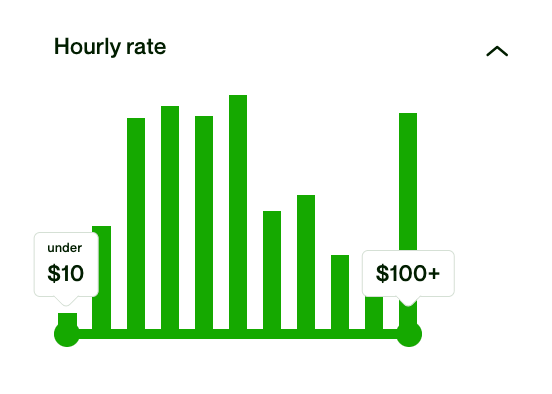
This tells me that an hourly rate of $50 is about right, or $100+ for a premium service.
For a more accurate market rate though let’s find the profiles that are most similar to you and your skills.
Note down their hourly rates. Then take an average.
I was about to give you a ChatGPT prompt for this…tells you how reliant on ChatGPT am I doesn’t it! We can take an average easily without ChatGPT!
Just add all the hourly rate together and divide by the number of rates you collected. Ie. if I had $30, $40, $60 as rates I’d add them up to $130 and divide by 3 for an average of $43.3.
Do this for your niche to work out the basic market rate for your skill. We use this as the base. This is our lowest rate.
If you are working a 9-5 and want to get out let’s run another exercise.
Work out your current hourly rate. This might be tricky as you are paid an annual salary.
Divide your annual salary by 2,000 - which is 8 hours a day, 5 days a week for 50 weeks a year. This is rough but will do the job.
If your annual salary is $50,000 then your hourly rate is $25/hour.
We want to make sure that our freelance hourly rate is at least 2x our current 9-5. Why? Because you won’t be working full time hours when freelancing - there will always be gaps. Giving us a 2x multiplier means we can afford to work up to half the time and still break even on our current salary.
If the freelance rate is at least 2x your current hourly great. That market rate basically works for you. You will be able to charge more later and also productise your service for even higher profits but for now we’re just doing a basic sense check.
If the freelance rate is dramatically lower than 2x your current 9-5 salary then I would look to see how you can shift into a more premium niche or at least provide a much more premium service in your current niche.
List this as your freelance rate on Upwork so people know your pricing range.
2. Project rate
Often on Upwork the work will not be per hour but instead per project. You’ll either be given a price by the client or you need to pitch a price.
Once you have your hourly rate we have the basics we need to work out our project rate. Here’s how.
First we need to estimate how long the project will take. This will come from experience. It’s always a good idea to add a buffer to deal with unforeseen circumstances and general annoyances.
Let’s say you read a task description and think it’ll take 10 hours.
Double it.
Assume 20 hours. It always takes longer than initial estimation.
Now multiply the number of hours by your hourly rate - $50 - for $1,000. That’s the base price of the project.
If the client is suggestion $100, don’t do it. We’re done with low cost projects to increase our reviews. We only take projects that our worth our time.
As you take on more and more gigs you’ll be better able to estimate timings. Until then be conservative and always assume more.
Also as you progress continue to increase your hourly rate. There’s no harm testing this on Upwork, just keep increasing it after each job and see if you continue to get gigs. If so, keep increasing.
3. Portfolio
As we take on more and more work make sure to continue to collect reviews from happy customers - this is the lifeblood of Upwork.
There’s another valuable social proof we can add to Upwork that many freelancers don’t bother to. This is great news for us.
We can upload details to our Portfolio to provide case studies about our past work. These allow us to go into detail about what problems we’ve helped solve.
Importantly these appear as one of the very few visual elements on Upwork:
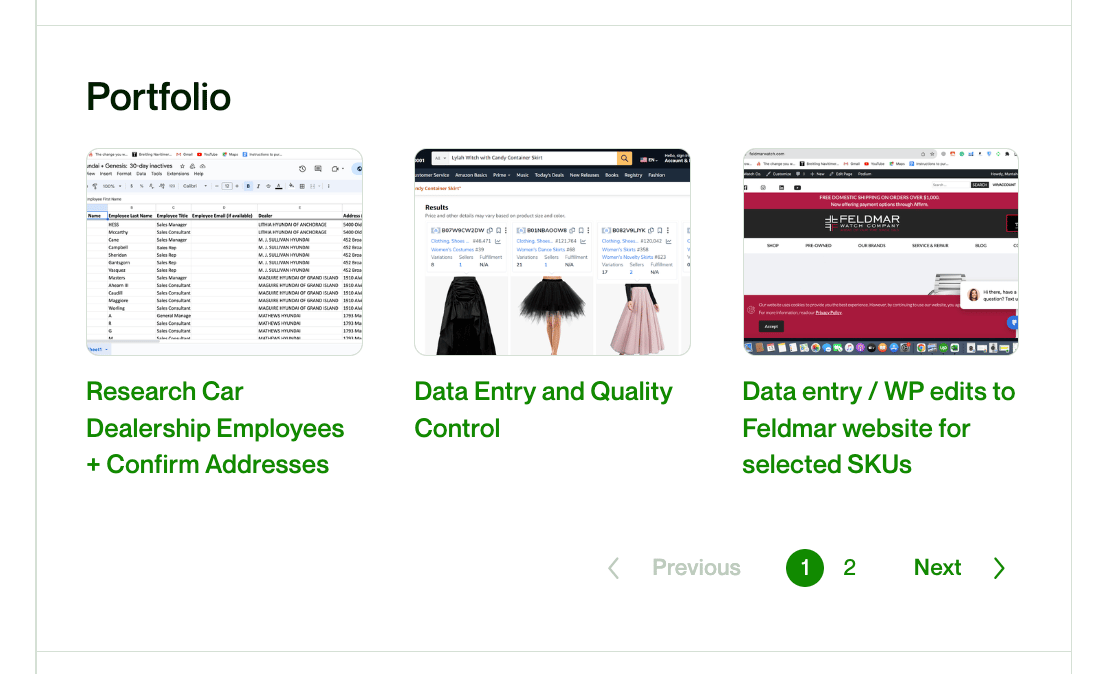
Designers often use the Portfolio function as their work is obviously visual. But you should be using it regardless of your skills because it allows us to add a written case study:
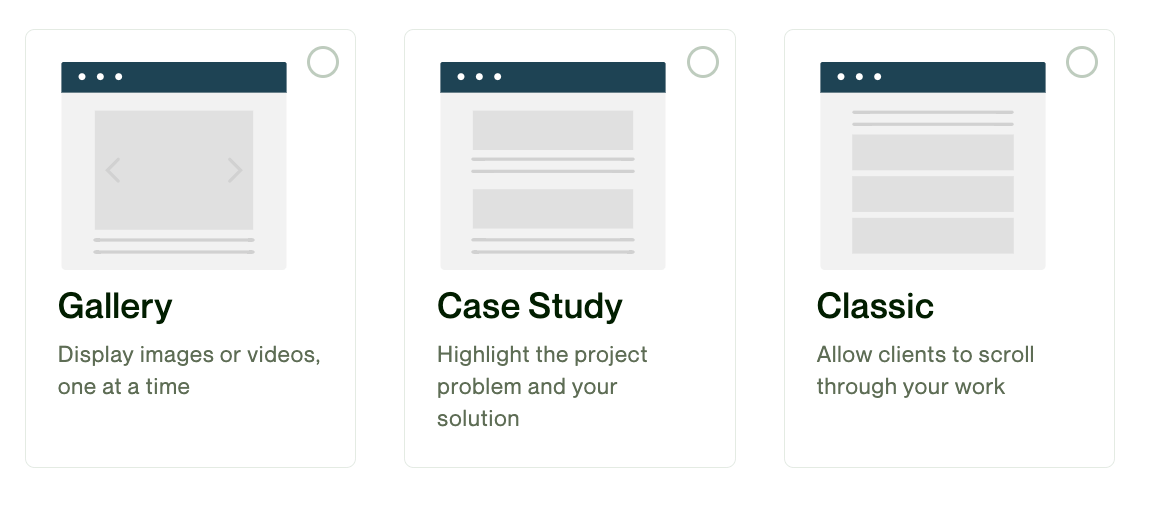
If your work is visual then this is simple - use the Gallery.
If it’s non-visual then we’ll use a prompt to help us generate a case study.
Here’s the prompt:
Act as a freelancing expert
Craft a case study about a job I recently completed for a client
The client's project was: [copy paste initial job description]
Ask me a series of 5 questions, one at a time, to collect information required to generate a compelling case study about how I solved the client's problem.
Output format:
Role, one line
Project task/challenge, rewritten for clarity
Project solution, in depth.For the example I used a gig about Email Funnel design and answered the questions accordingly.
Prompt Output:
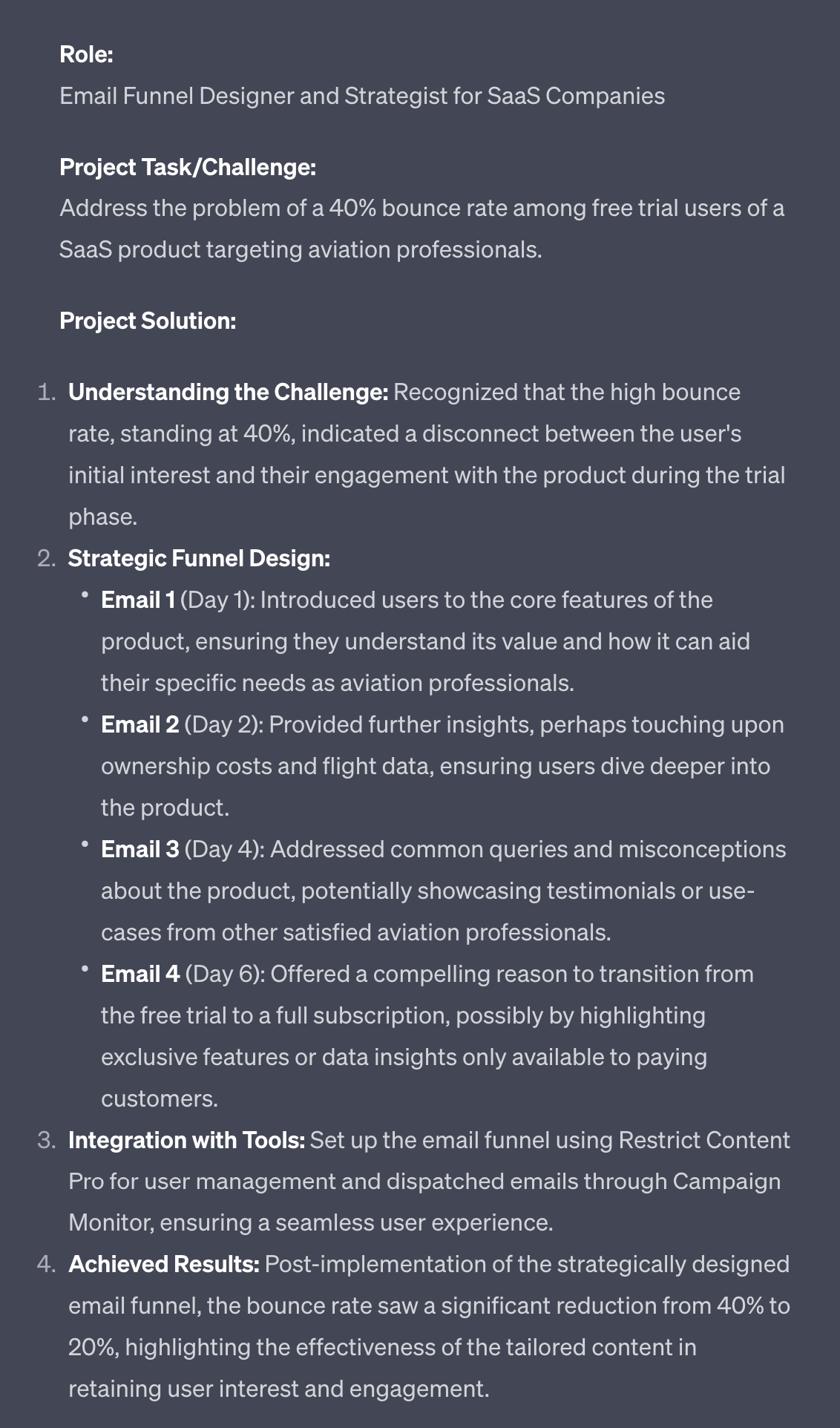
The output is in the format required by Upwork. Simply copy/paste the details in. You’ll also need to add an image - a screenshot of the client’s website would be a good image here.
5. Premium Prompt - Carousel
As a bonus we can use the more visually attractive gallery for our case studies. Even if our case study is text based.
This will really help distinguish us from the competition as this unusual visual format will be a pattern break.
First up use this prompt below your case study that we just generated:
Convert this case study into a Twitter thread.
Short, concise tweets.
No emojis, no hashtags.Prompt Output:
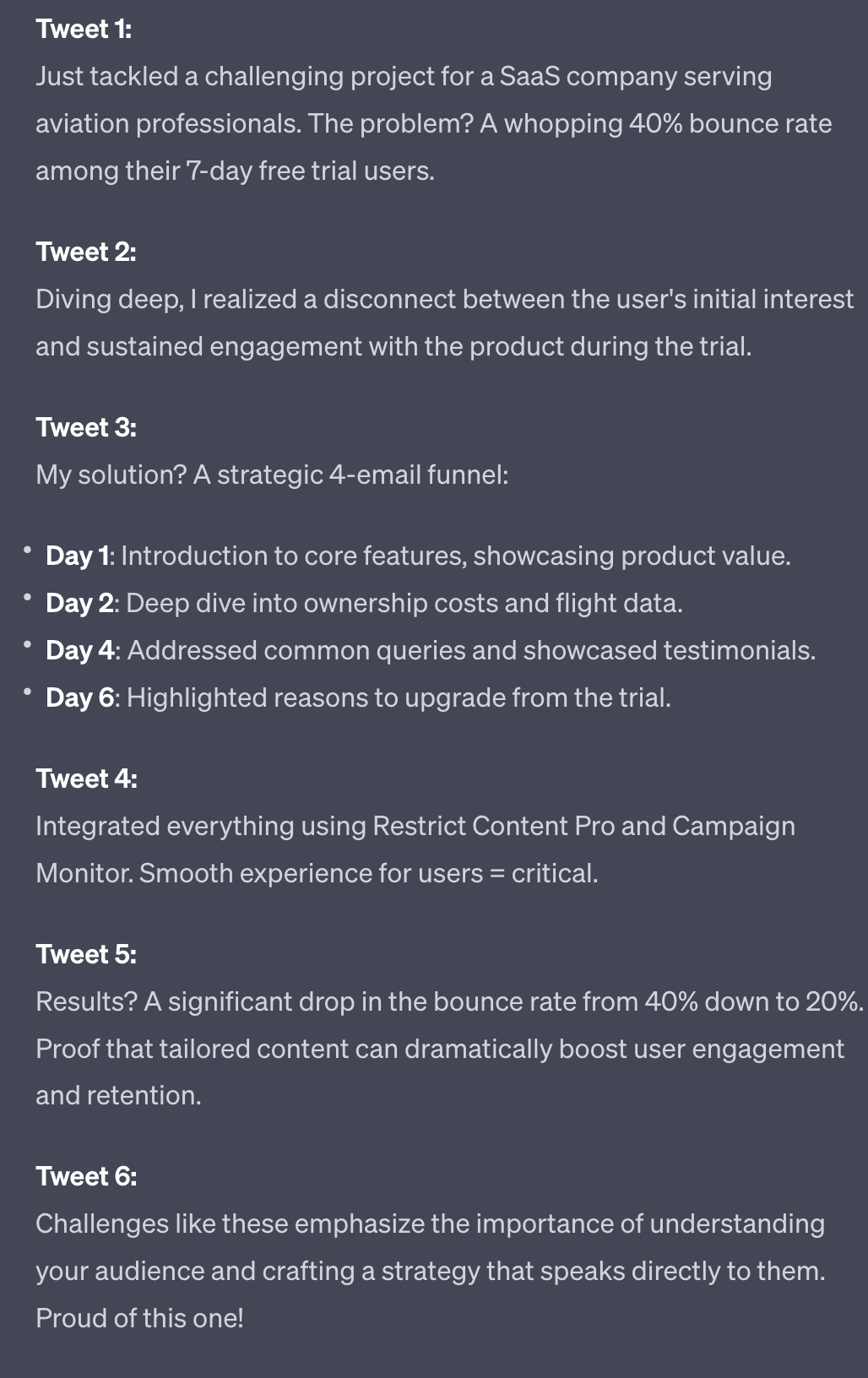
Edit the posts to your liking and post them to X/Twitter. This helps you announce that you are open for freelance business which is a nice bonus benefit.
What we really want to do though is take the thread and convert it into images for a carousel.
Go to Tweetpik and add the URL of the thread tweets. You can then download each tweet as an individual image.
We take these individual images over to Upwork and upload them as gallery images in the Portfolio section:
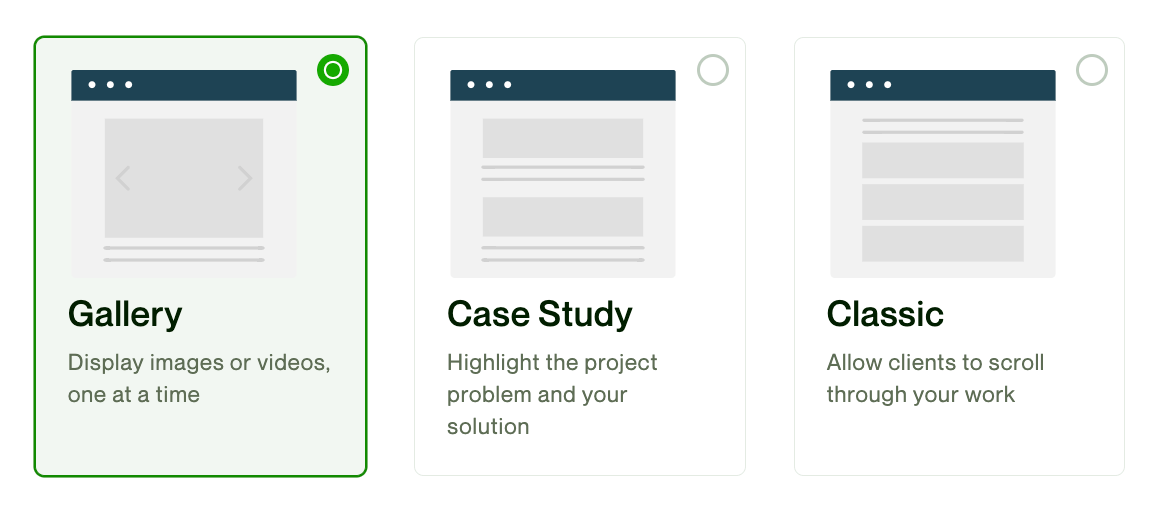
This will create a much more readable and visually attractive version of our case study in our Upwork profile. It’s also an unusual technique and as such will help differentiate from your competition.
Pulling it together
Now that we have a healthy growing Upwork profile we can start to think about next steps.
Specifically how to productise our service into repeatable templated work and even launch a full service business of the back of our experience working freelance.
We’ll jump into that in the next Part.
A reminder of what we’re covering this week :
Part 1: Your freelance offer
Part 2: Building your freelance profile
Part 3: Securing your first freelance clients
Part 4: Marketing your freelance work
Part 5: Growing Your freelance business